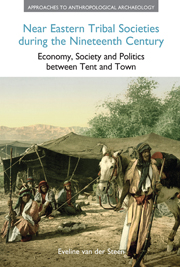 Near Eastern Tribal Societies during the Nineteenth Century
Near Eastern Tribal Societies during the Nineteenth Century Book contents
- Frontmatter
- Dedication
- Contents
- Acknowledgements
- Introduction
- 1 What is a tribe?
- 2 Travellers in the Levant during the nineteenth century
- 3 The dynamics of territorial and power structures
- 4 Oral traditions
- 5 Tribal society and its relation to the landscape
- 6 Tribal institutions
- 7 Relations between the tribes and the state
- 8 From tribe to tribal state: three case studies
- 9 The economy of tribal societies
- 10 Ethnicity and the sense of belonging
- 11 Women in tribal societies
- 12 Religion and folklore
- 13 Back in time: historical parallels
- Notes
- References
- Index
9 - The economy of tribal societies
- Frontmatter
- Dedication
- Contents
- Acknowledgements
- Introduction
- 1 What is a tribe?
- 2 Travellers in the Levant during the nineteenth century
- 3 The dynamics of territorial and power structures
- 4 Oral traditions
- 5 Tribal society and its relation to the landscape
- 6 Tribal institutions
- 7 Relations between the tribes and the state
- 8 From tribe to tribal state: three case studies
- 9 The economy of tribal societies
- 10 Ethnicity and the sense of belonging
- 11 Women in tribal societies
- 12 Religion and folklore
- 13 Back in time: historical parallels
- Notes
- References
- Index
Summary
The Tiyaha had large camel and goat herds, and in the areas of the Negev where it was feasible they practiced agriculture. Their protection of the Hajj route between Jebel Husn and Nakhl was also lucrative, particularly since they could claim taxes on the goods sold in the Nakhl market. Apart from that, in the 1930s they still had the monopoly on guiding the route from Gaza to Nakhl. They had a complicated arrangement with the Towara, who had the guiding and protection rights to the south and west of Nakhl.
(Von Oppenheim 1943: 148)Introduction
The more romantic descriptions of Bedouin often describe them as nomadic pastoralists, wanderers, avoiding the settled lands, continually on the move with their camels, doing a bit of raiding and robbing on the side. This image derives largely from the Rub' al-Khali, the “empty quarter” of Arabia, where people like Harry St John Philby (1933) and Bertram Thomas (1938) saw the Murra living mostly on camel's milk, with some gazelle or hare from the hunt; camping in small groups to make the most of the small patches of pasture in a dry desert, where rain seldom fell; expert trackers, raiding and being raided in turn.
In ancient times, Egyptian Bronze Age inscriptions and Assyrian and Babylonian documents also associate kin-based nomadic societies with pastoralism, as well as with a warlike, aggressive nature, opposed to settlement and government control. According to the Bible, long seen as the ultimate source of information for the region, the patriarchs of the Tribes of Israel were goat, sheep and camel breeders, wandering nomads, until they wandered into the Promised Land and became settlers.
- Type
- Chapter
- Information
- Near Eastern Tribal Societies during the Nineteenth CenturyEconomy, Society and Politics between Tent and Town, pp. 166 - 190Publisher: Acumen PublishingPrint publication year: 2013


